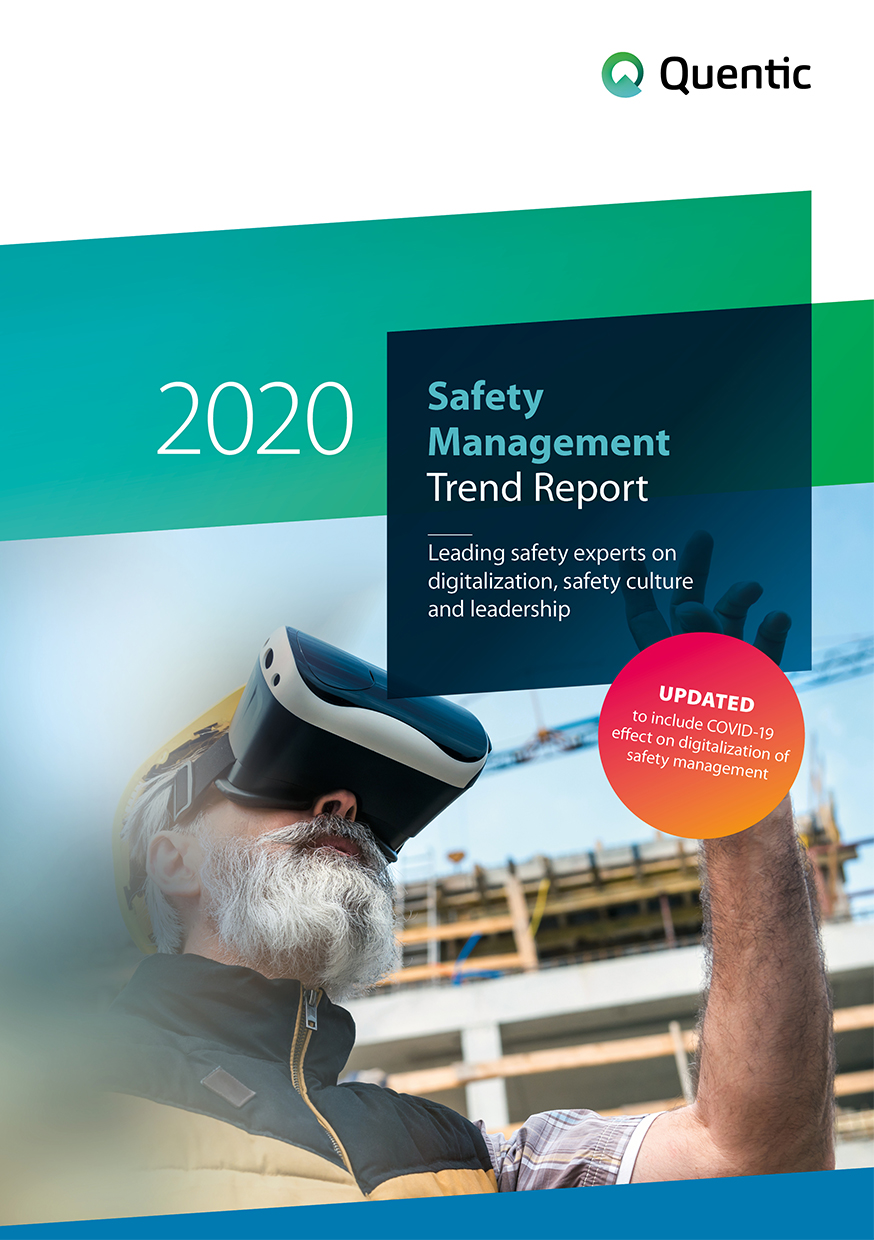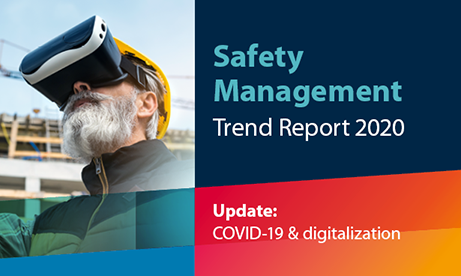Leading experts give their opinions on digitalization, leadership and the effect of COVID-19 on occupational safety management
In the annual Safety Management Trend Report, renowned industry experts from around the world share their views on the most significant developments in safety management. They conclude that overall digitalization, and advances in software in particular, have positively influenced safety management and support modern EHS approaches. With the accelerated increase of digital work in response to the coronavirus pandemic, experts consider a long-lasting impact on digital EHS management to be very likely. The Safety Management Trend Report presents a wide range of perspectives from different professionals and brings together some of the world's leading experts, including Andrew Sharman, Davide Scotti and Eduardo Blanco-Munoz. The trend report is published annually by Berlin-based Software as a Service vendor Quentic, which provides a platform and app for Health and Safety (EHS) management and Corporate Social Responsibility (CSR).
What are the key trends in safety management? Does digitalization and new technology make work safer? And what impact will the COVID-19 pandemic have on digital safety management? Each year, Quentic, a Software as a Service vendor providing environmental, health and safety management (EHS) and Corporate Social Responsibility (CSR) software solutions, asks internationally renowned safety professionals about their views on and assessments of current trends. For the Safety Management Trend Report 2020, fifteen experts, from nine countries were invited to share their insights.
Digitalization and technology are having a positive impact on safety management
When asked about digital advances in safety management, the expert panel largely agrees that technological innovation has influenced safety management positively. In particular, they stress that software and mobile devices have brought structure and consistency to data inputs. This provides the basis for meaningful analysis and data-driven decision making which translates into operational improvements for both safety professionals and workers alike.
“Safety apps are now widely available on mobile devices, enabling safety practitioners to save valuable time that they would otherwise have wasted in doing paperwork” summarizes Eduardo Blanco-Munoz in the report.
With regards to the sudden challenges arising as the coronavirus spreads, most experts agree that safety management will benefit from the overall acceleration of digitalization in the workplace. The greatest potential is seen in the field of safety training. Interestingly, this assessment is similar to the application of technologies such as artificial intelligence (AI), virtual reality (VR), or the Internet of Things (IoT) in the safety field. Many experts are enthusiastic about the opportunities of VR in safety training, but remain cautious about applications beyond. Effective safety management needs adequate processes and a good safety culture. Digital tools, when incorporated skillfully, can support these, but they cannot create them.
Good safety management requires a holistic approach and skilled communication
When asked about areas for improvement, the panel of experts almost unanimously pointed out to communication and leadership. Safety managers should “deliver an output that can touch both hearts and minds of our audiences” (Davide Scotti), “interpret regulatory requirements and technical concepts - and translate these into comprehensible and practical actions for managers and leaders” (Andrew Sharman) and share knowledge by training their workforce constantly. At the same time, EHS tasks are becoming more and more diversified. The question arises: do we need more specialization and does the job description need to be reassessed?
Different schools of thought – one conclusion
Each year, the Safety Management Trend Report endeavors to give a broad insight and unique perspectives on the most discussed topics in the field. A number of experts advocate for Behavior Based Safety (BBS), Safety II or are part of the Safety Differently movement. Others campaign actively for “Vision Zero”. However, they are united in a common purpose, which they share with EHS professionals from all over the world: they want to prevent harm from coming to people in their work environment. The panelists in this report therefore show great appreciation for the safety professionals, who, with their committed engagement, make work and the world safer every day.
The full report can be downloaded on: www.quentic.com/safety-trends
Sample quotes from the Safety Management Trend Report 2020
What are the most important trends in safety management in 2020?
"Digitalization and automation, improvement of risk assessment and implementation of behavior-based prevention." Dr. Sven Timm
In which areas of safety management do you see a large potential for improvement?
“Communication (…) OSH practitioners need to understand not just the vocabulary of their business - the language their leaders and stakeholders speak - but also how to concisely craft and convey their messages with care, clarity and influence.” Professor Dr. Andrew Sharman
Which technologies have had the biggest impact on workplace safety in recent years? How?
"Safety apps are now widely available on mobile devices, enabling safety practitioners to save valuable time that they would otherwise waste doing paperwork." Eduardo Blanco-Munoz
What impact do you expect emerging technologies to have on safety management?
"VR (virtual reality) in safety training will be the next big leap in the coming few years because it makes it possible to train potentially dangerous tasks in a safe way and in safe environment. There will be new research results of VR learning from FIOH in 2020." Tiina-Mari Monni
Do you think that the pandemic crisis will lead to a faster digitalization of safety management?
"Absolutely yes. The level of risk perception on both leaders and the workforce will increase dramatically. This scenario offers every organization the opportunity to raise the entire level of HSE management system. This will include a boost in innovation, especially in the digitalization of HSE training, not only through e-learning. The challenge will be to deliver practical and fully engaged training at distance." Davide Scotti
Press pictures
Safety Management Trend Report 2020 title page
Safety Management Trend Report 2020 (landscape format)
About the panelists quoted in the press release
Tiina-Mari Monni
Tiina-Mari Monni leads the Vision Zero Forum at the Finnish Institute of Occupational Health (FIOH). She has over 20 years of experience in development and managing positions in OSH organizations.
Eduardo Blanco-Munoz
Is a HSE & Industrial Risks Director in the aerospace industry. He teaches Behavior-Based Safety (BBS) and Safety Culture at University of Paris 13.
Davide Scotti
Davide Scotti is head of the corporate HSE culture, communication & training department at Saipem, and General Secretary of the LHS Foundation.
Professor Andrew Sharman
Andrew Sharman is President of IOSH - the Institution of Occupational Safety & Health. He is also the Professor of Leadership & Culture at the European Centre for Executive Development on the INSEAD campus in France, and teaches at IMD, Switzerland, and the California Institute of Technology. Andrew is the author of nine books on culture, leadership & well-being.
Dr. Sven Timm
Dr. Sven Timm holds a PhD in Geology and is a trained coordinator for Works on Contaminated Sites, Environmental Protection and Industrial Hygiene. Today, he is Head of the Central Prevention Division “Strategic Cooperation” at the German Social Accident Insurance (DGUV)
About Quentic
Quentic is one of the leading providers of Software as a Service solutions for the European EHS and CSR markets. The company is headquartered in Berlin, Germany, and employs more than 250 people. Branch offices are located in Germany, Austria, Switzerland, Finland, Sweden, Denmark, Belgium, the Netherlands, France, Spain and Italy. Over 700 customers have chosen Quentic software solutions to enhance their EHS and CSR management.
With nine individually combinable modules, the online platform comprises Health & Safety, Risks & Audits, Hazardous Materials, Legal Compliance, Control of Work, Online Instructions, Processes, Environment, and Sustainability. By offering a tailored combination of its Health & Safety and Online Instructions modules, as well as ready-to-use instructions and risk assessments, Quentic is currently supporting companies across Europe in implementing new safety standards to combat the COVID-19 pandemic. The platform provides excellent support for comprehensive management systems certified in ISO 14001, ISO 50001 and ISO 45001.

